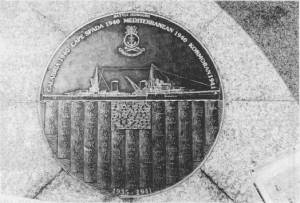- Author
- Zammitt, Alan
- Subjects
- History - general
- Tags
-
- RAN Ships
- HMAS Sydney IV, HMAS Sydney III, HMAS Sydney I, HMAS Sydney II
- Publication
- July 1992 edition of the Naval Historical Review (all rights reserved)

Photo by Alan Zammit
As part of the fiftieth anniversary of the loss of the cruiser HMAS SYDNEY with her entire complement of 645 sailors, a beautiful granite memorial with four bronze plaques featuring each of the four SYDNEY’S silhouettes, Battle Honours, years in commission and listing the names of each man killed in action in time of war, is located at Bradley’s Head (Sydney Harbour) set behind the first SYDNEY’S tripod mast.
His Excellency Rear Admiral Peter Sinclair, AO, Governor of New South Wales, unveiled the memorial. The Governor had served in HMAS SYDNEY III.
In his address to over 200 guests at the Memorial Dedication, the Hon. Peter Collins, QC, Minister for the Arts, spoke of the four SYDNEYs. Apart from being a senior N.S.W. Government Minister, Peter Collins is a Lieutenant Commander in the RANR and he and his Ministry for the Arts were responsible for the Memorial which just cannot be faulted.
The only man at the Service to have served in the first SYDNEY was 86 year old Hughie Davies. He joined the famous cruiser in 1921 as a 15 year old boy Seaman from the Boy’s Training Ship HMAS TINGARA. Hughie was serving in HMAS SYDNEY (2) in 1939. He was drafted from the ship before she sailed for the Mediterranean.
There is no one left who was serving in HMAS SYDNEY on November 9, 1914, when the then modern 5,400 ton SYDNEY went into action with H.I.G.N.S. EMDEN. SYDNEY suffered fifteen hits. However, ten shells failed to explode. Four of SYDNEY’S crew were killed and twelve wounded. The EMDEN’s 4.1 inch guns fired 38 lb shells. Her gun’s range was about 10,500 yards. The faster SYDNEY moved out of range of EMDEN and SYDNEY’S six inch 100 lb shells with a range of 14,000 yards pounded EMDEN to a 3,600 ton wreck and after an action of 1 hour 40 minutes Captain von Muller ran his ship onto North Keeling Island reef. The EMDEN’s crew suffered 134 killed, 65 wounded and 110 taken prisoner. Fifty of the EMDEN crew who were ashore when the action took place escaped in the old Cocos Island schooner AYESHA and eventually after an adventurous journey returned to Germany via Arabia to a hero’s welcome.
When Captain Glossop signalled “EMDEN beached and done for” so ended the life of a German light cruiser operating without a base or fresh provisions which in three short months of active service steamed 30,000 miles and carried out one of the most successful hostile voyages in Naval history, sinking a Russian light cruiser, a French destroyer, sinking or capturing over 20 ships as well as destroying oil installations in India.
SYDNEY’S destruction of EMDEN meant that the Indian Ocean was safe for allied shipping and the warships hunting for the German raider could be transferred to the Atlantic.
After the EMDEN action, SYDNEY operated in the North Atlantic, West Indies, South Atlantic, took part in the surrender of the German Fleet and did not return to her home base Sydney until July 1919, 4 years 9 months after SYDNEY sailed with the first ANZAC convoy to the Middle East.
At the unveiling of the HMAS SYDNEY Memorial there were about 12 of the wartime crew of HMAS SYDNEY who left the ship in 1941. No one formed a HMAS SYDNEY Association in New South Wales after the war. Mr Douglas Price, saddened by seeing no HMAS SYDNEY banner of Anzac Day, founded a SYDNEY Association and was a member of the HMAS SYDNEY Memorial Committee.
The second SYDNEY completed in 1935 had a displacement of 7,198 tons, near 9,000 tons fully loaded on July 19, 1940 under the command of Captain J A Collins, RAN, later Vice Admiral Sir John Collins, KBE, CB. HMAS SYDNEY patrolling north of Crete received a report that British destroyers were being pursued by two Italian Cruisers. They were the BARTOLOMEO COLLEONI and the GIOVANNI DELLE BANDE NERE. Being outgunned the four destroyers turned towards HMAS SYDNEY with HMS HAVOCK. Captain Collins allowed the crew of HMAS SYDNEY to have breakfast before going into action. SYDNEY scored hits heavily damaging the BARTOLOMEO COLLEONI which was finished off by torpedoes from the British destroyers while SYDNEY with HMS HERO chased the other cruiser, one of the fastest warships in the world, which was able to escape at high speed.




